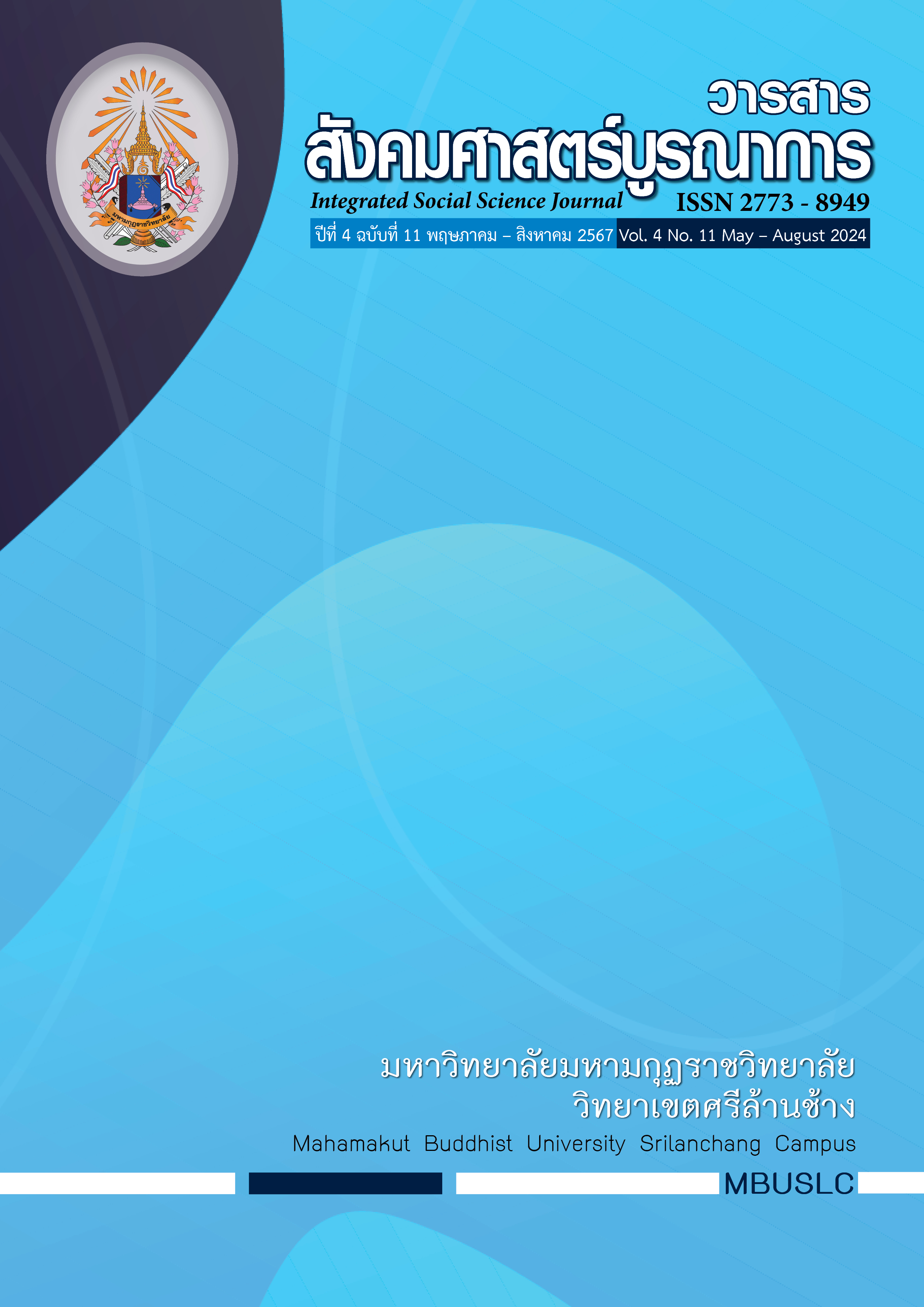AN EXPERIMENT UTILIZING ROSELLE FOR ASSESSING GROUNDWATER QUALITY IN AN ENVIRONMENTAL CHEMISTRY CONTEXT FOR GENERAL CHEMISTRY 2 STUDENTS AT LOEI RAJABHAT UNIVERSITY
Main Article Content
Abstract
This research, titled "An Experiment Utilizing Roselle for Assessing Groundwater Quality in Environmental Chemistry Learning for General Chemistry II Students at Loei Rajabhat University", aims to investigate the use of roselle in testing groundwater quality and compare learning outcomes before and after employing roselle to assess groundwater quality and analyze ferric ion presence. Anthocyanin, known for its sensitivity to color changes when interacting with iron ions, was selected for this experiment. Additionally, the integration of smartphones in chemical detection has gained significant interest due to their ability to capture images and process data quickly. Smartphones can be utilized to analyze color changes in solutions that correspond to ferric ion concentrations, simplifying the detection process and making it applicable in diverse settings. The study utilized an experimental research methodology with a sample group of 30 General Chemistry II students. The experiment involved preparing groundwater samples with various ferric ion concentrations (0.5, 1.0, 2.0, 5.0 ppm), extracting anthocyanin from roselle by boiling, mixing the anthocyanin extract with groundwater samples, and measuring the color intensity of the solutions using a smartphone. A UV-Visible spectrophotometer was also employed to measure the absorbance of the solutions. The study assessed learning outcomes by conducting pre- and post-tests to gauge students' knowledge. The results indicated that using anthocyanin from roselle in conjunction with a smartphone effectively measures color intensity, which correlates with ferric ion concentration. A linear relationship was observed between color intensity and ferric ion concentration. Smartphone results were highly correlated with absorbance values from the UV-Visible spectrophotometer, demonstrating the practicality of the proposed method for teaching. In terms of learning outcomes, post-test scores (mean 25.60) showed a statistically significant improvement at the .05 level compared to pre-test scores (mean 5.23), suggesting the experiment improved students' understanding and interest in environmental chemical measurement and analysis. This research underscores the benefits of using anthocyanin from roselle and smartphones for detecting ferric ions in groundwater, offering a cost-effective, convenient, and environmentally friendly method. The use of smartphones as measurement tools reduces the complexity and cost of laboratory sample analysis, making environmental chemistry more accessible. Students can perform experiments and view results immediately.
Article Details

This work is licensed under a Creative Commons Attribution-NonCommercial-NoDerivatives 4.0 International License.
บทความที่ได้รับการพิจารณาจากคณะกรรมการผู้ทรงคุณวุฒิและเผยแผ่ในวารสารฉบับนี้ เป็นทัศนคติและข้อคิดเห็นส่วนบุคคลของผู้เขียนแต่ละท่าน ไม่ถือว่าเป็นทัศนะคติและความรับผิดชอบ
ของบรรณาธิการ
บทความ ข้อมูล เนื้อหา รูปภาพ ฯลฯ ที่ได้รับการตีพิมพ์ในวารสารสังคมศาสตร์บูรณาการ ถือเป็นลิขสิทธิ์ของวารสารสังคมศาสตร์บูรณาการ หากบุคคลหรือหน่วยงานใดต้องการนำทั้งหมดหรือส่วนหนึ่งส่วนใดไปเผยแพร่ต่อหรือเพื่อกระทำการใด ๆ จะต้องได้รับอนุญาตเป็นลายลักอักษรจากวารสารสังคมศาสตร์บูรณาการ ก่อนเท่านั้น
References
รวิวรรณ วัฑฒนายน, ซูรายา สะตาปอ, บิสมี ยามา, สาลูมา สมานหมาน, & ปิยาภรณ์ วังศิริกุล. (2017). การ ตรวจวัดไอออน เหล็กโดยใช้แอนโทไซยานินจากกระเจี๊ยบแดง. Princess of Naradhiwas University Journal, 9(2), 97-103.
Anastas, P., & Eghbali, N. (2010). Green chemistry: principles and practice. Chemical Society Reviews, 39(1), 301-312.
Baird, C., & Cann, M. (2012). Environmental chemistry. W.H. Freeman.
Castañeda-Ovando, A., Pacheco-Hernández, M. D. L., Páez-Hernández, M. E., Rodríguez, J. A., & Galán-Vidal, C. A. (2009). Chemical studies of anthocyanins: A review. Food Chemistry, 113(4), 859-871.
Chanchang, J. (2020). Integrated Teaching and Learning Management for the Development of Higher Order Thinking Skills: Learning to Practice (การจัดการเรียนการสอนแบบบูรณาการเพื่อ พัฒนาทักษะการคิดขั้นสูง: การเรียนรู้สู่การปฏิบัติจริง). Journal of Education Studies, 48(3), 78-89.
Conrad, C. C., & Hilchey, K. G. (2011). A review of citizen science and community-based environmental monitoring: issues and opportunities. Environmental Monitoring and Assessment, 176(1), 273-291.
Freeman, S., Eddy, S. L., McDonough, M., Smith, M. K., Okoroafor, N., Jordt, H., & Wenderoth, M. P. (2014). Active learning increases student performance in science, engineering, and mathematics. Proceedings of the National Academy of Sciences, 111(23), 8410-8415.
Inai, K., & Phonchamni, S. (2023). การเสริมสร้างศักยภาพครูเพื่อพัฒนาทักษะการคิดวิเคราะห์ สำหรับ นักเรียนโรงเรียนตำรวจตระเวนชายแดน. Rajapark Journal, 17(52), 128-142.
Intaravicha, N. (2020). ประสิทธิภาพการวัดค่าการ ดูดกลืนแสง ด้วยโปรแกรม Shoebox Spectrophotometer ที่ทำงานบ สมาร์ทโฟนในการวัดปริมาณฟอสฟอรัสในดินโดยวิธีทำให้เกิดสีด้วยโมลิบดินัมบลู. Thai Agricultural Research Journal, 38(2), 150-160.
Sanitklang, S., Boonsom, S., & Na-Ek, N. (2023). การเปรียบเทียบประสิทธิภาพของวิธีการเติมคลอรีนในการผลิตน้ำบริโภค. Journal of Health Science of Thailand, 32(6), 1076-1083.
Yetisen, A. K., Akram, M. S., & Lowe, C. R. (2013). Paper-based microfluidic point-of-care diagnostic devices. Lab on a Chip, 13(12), 2210-2251.

